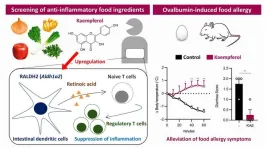Allergic diseases such as asthma, atopic dermatitis, and food allergies have been increasing in frequency over the last few years. Food allergies in particular affect millions of people worldwide—this includes allergies to foods such as milk, peanuts, eggs and shellfish. They are typically caused by the immune system being hypersensitive to harmless substances in foods and the environment. Flavonoids are chemicals present in various fruits and vegetables that are known to have anti-allergic effects and show promise as natural allergic treatments.
To better understand how these allergies can be treated, let’s look at an interesting anti-allergic mechanism in our cells. In the intestines, specialized dendritic cells (DCs) produce an enzyme called RALDH2 (retinaldehyde dehydrogenase 2) which converts retinal, a chemical derived from vitamin A, to retinoic acid. This retinoic acid then promotes the development of regulatory T-cells, a type of immune cell that can suppress the immune response observed in allergies.
Clearly, RALDH2 plays an important role in combating food allergies; however, are there any flavonoids that can increase RALDH2 levels in DCs?
This was the question answered by a group of researchers led by Professor Chiharu Nishiyama at the Tokyo University of Science (TUS), in a letter published online in Allergy on December 11, 2024. In their study, the authors screened around 40 different flavonoids to see if they increased RALDH2 levels in DCs. The most effective of these was a compound called kaempferol, which they chose to study further. The primary contributors to this study were Ms. Miki Takahashi, a 2023 graduate from TUS, Dr. Kazuki Nagata, Assistant Professor at TUS, and Ms. Yumi Watanuki, a 2019 graduate from TUS.
Kaempferol is found in a variety of foods such as kale, beans, tea, spinach, and broccoli. It is also one of the most heavily studied flavonoids due to its beneficial effects on the human body. The researchers observed that kaempferol treatment increased the expression and efficiency of RALDH2 in DCs. Additionally, the kaempferol-treated DCs were found to promote regulatory T-cell development, underscoring its role in controlling the immune response.
To understand the exact mechanism involved in this process, they focused on a ‘receptor’ called aryl hydrocarbon receptor (AhR) which is targeted by kaempferol. Their experiments on DCs suggested that kaempferol acts as an ‘antagonist’ or blocks AhR, which in turn accelerates regulatory T-cell development. The next step was to look at factors affecting the Aldh1a2 gene, which actually produces Radlh2.
“In the past, we reported that PU.1 and IRF-4 were key molecules that regulated the Aldh1a2 gene in dendritic cells,” says Prof. Nishiyama. “In this study, we found that PU.1 and IRF-4 expression and function were enhanced in dendritic cells stimulated with kaempferol,” she further explains, elucidating the PU.1/IRF-4-dependent mechanism behind kaempferol’s anti-inflammatory effects.
To see how kaempferol affected immune responses in living organisms, the researchers induced allergies in mice using the OVA (ovalbumin) protein found in egg whites. They found that administering kaempferol to these mice alleviated their allergic symptoms. “The rapid decrease in body temperature and allergic diarrhea observed after OVA administration were significantly suppressed in mice that were administered kaempferol,” explains Prof. Nishiyama.
These results indicate that kaempferol is a very promising natural treatment for food allergies. However, the authors note that further studies are required, especially with human cells, to replicate these results and actually use kaempferol as an allergy medicine. While this study focused on kaempferol’s role in reducing inflammation, flavonoids as a whole are very promising anti-allergic compounds, as they are present in a large variety of foods.
The authors suggest that the chemical structure of flavonoids may play a role in their ability to accelerate regulatory T-cell development. This has significant implications for how we treat allergies—regular intake of foods containing high amounts of flavonoids could serve as natural remedies to alleviate allergic symptoms.
Further emphasizing the importance of supplementing your daily diet with flavonoids, Prof. Nishiyama says, “When taken as a daily food, they are expected to reduce allergies, inflammation, and autoimmune diseases that are caused or aggravated by excessive immune response.”
We are confident that these findings will provide new hope to people worldwide suffering from food allergies!
***
Reference
DOI: https://doi.org/10.1111/all.16410
About The Tokyo University of Science
Tokyo University of Science (TUS) is a well-known and respected university, and the largest science-specialized private research university in Japan, with four campuses in central Tokyo and its suburbs and in Hokkaido. Established in 1881, the university has continually contributed to Japan's development in science through inculcating the love for science in researchers, technicians, and educators.
With a mission of “Creating science and technology for the harmonious development of nature, human beings, and society," TUS has undertaken a wide range of research from basic to applied science. TUS has embraced a multidisciplinary approach to research and undertaken intensive study in some of today's most vital fields. TUS is a meritocracy where the best in science is recognized and nurtured. It is the only private university in Japan that has produced a Nobel Prize winner and the only private university in Asia to produce Nobel Prize winners within the natural sciences field.
Website: https://www.tus.ac.jp/en/mediarelations/
About Professor Chiharu Nishiyama from Tokyo University of Science
Chiharu Nishiyama is a Professor at the Faculty of Advanced Engineering, Department of Biological Science and Technology. She received her postgraduate degree in 1997 from the Department of Agricultural Chemistry at the University of Tokyo Graduate School, followed by a Ph.D. from the University of Tokyo. Her areas of research interest include applied biochemistry, covering fields such as immunology, allergy, molecular biology, transcription factors, and cell development. Prof. Nishiyama has published over 140 research papers in international journals. She also received the prestigious JSBBA Award for Young Scientists in 2005, the JSA Award for Young Scientists in 2005, and the JAFI Award in 2019.
Funding information
This work was supported by Grants-in-Aid for Scientific Research (B) 23K26860, 23H02167, and 20H02939 (CN); a Research Fellowship for Young Scientists DC2 and a Grant-in-Aid for JSPS Fellows 21J12113 (KN); a Scholarship for a Doctoral Student in Immunology (from the Japanese Society for Immunology to NI); a Tokyo University of Science Grant for President’s Research Promotion (CN); the Tojuro Iijima Foundation for Food Science and Technology (CN); a Research Grant from the Mishima Kaiun Memorial Foundation (CN); and a Research Grant from the Takeda Science Foundation (CN).
END





